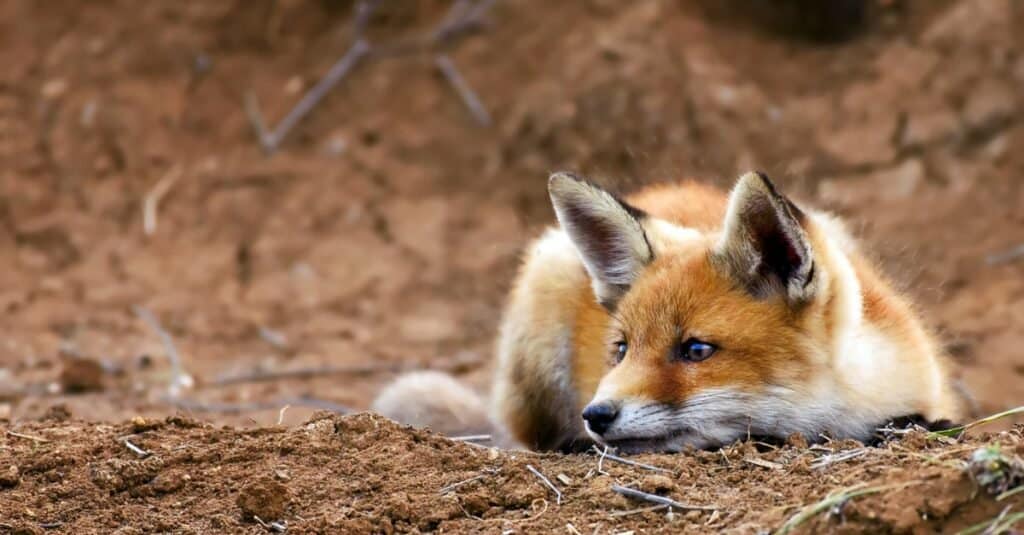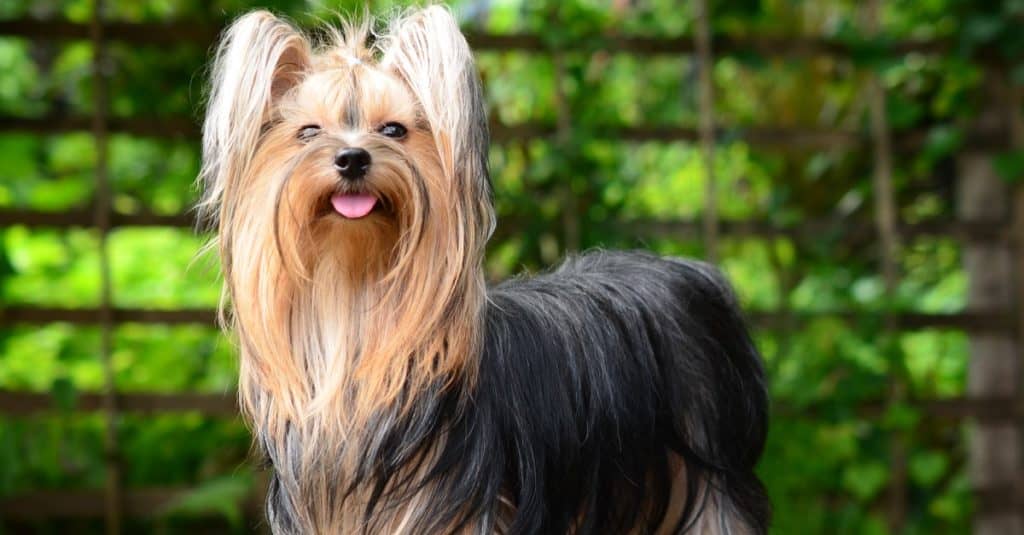Yorkies weren’t always companion dogs and lap dogs. Their spirited personalities lead to many misconceptions, like the idea that their boundless energy cannot be tamed enough to give them responsibilities. Small in size, many people think this limits the Yorkies’ capabilities. This is furthest from the truth.
The breed, which originated from the county of Yorkshire in England, was initially bred for “ratting.” Their task was to catch rats in mines and mills throughout northern England. These pups have an interesting history that brought them from being hunters to lap dogs.

Yorkshire Terriers were originally bred to hunt rats. Despite being dainty, they’re known for being feisty and bold.
©iStock.com/Kurt Pas
| Breed | Yorkshire Terrier |
|---|---|
| Height | 6 to 7 inches |
| Weight | 4 to 7 pounds |
| Grooming | Regular |
| Exercise | Daily walk |
| Role | Companion dog |
| Past roles | For ratting, hunter |
Description and Size
This famous toy dog breed is one of the smallest and cutest in the world. It has become the perfect dog for families because Yorkies are intelligent, energetic and hypoallergenic. Even those with allergies to fur and pet dander will not have to worry about this breed because Yorkies don’t shed much.
Typically, Yorkies stand only six to seven inches tall. They weigh about two to seven pounds, making them one of the world’s smallest and lightest dog breeds. This is also why Yorkies make great apartment dwelling dogs.
Yorkies have small heads and medium-sized muzzles. They also have a pair of small V-shaped ears that are set high and carried erect. The breed has a compact body with a well-balanced backside.
Its most notable feature is its coat. Long, fine and straight, the Yorkies’ fur needs regular maintenance and grooming. It is often tied up with a ribbon, giving this dog a haughty appearance. The hair color should be steel blue on the body and tail and tan on the other parts.
Original Job and Roles

Yorkies weren’t always as small as they are today and were able to hunt larger animals like the fox, in addition to rats.
©iStock.com/MriyaWildlife
It is easy to misconstrue Yorkies as nothing more than a lap dog. Petite and energetic, you won’t think Yorkies have had any other role in their lives than to be a companion. In truth, these dogs were initially bred to catch rats and burrow underground to chase badgers and foxes.
In the mid-1800s, rat infestation was a big problem in the mines and mills of northern England. The job of ratting fits the Yorkies’ size perfectly, so much so that they became some of the best at this job. Yorkies are not only small enough to get through the cracks and catch mice, but they also have a strong prey drive.
Eventually, even the working class brought home Yorkies to solve their rat problems. In rural areas, there was a “community ratting dog” to get rid of the pests. This breed did not stay with being a rat hunter alone. They transitioned into hunting bigger prey.
Yorkies weren’t always as small as they are now. They used to be bigger, so they quickly transitioned into hunting badgers, foxes and other small game. Yorkies are said to be very confident and courageous. They loved the thrill of hunting and would never back down no matter how larger the prey was.
How did Yorkies go about hunting prey? The dogs would chase the animal until they tried to hide underground in a burrow. The hunters or dog owners would dig open the burrow’s entrance so the dogs could enter. Once the dogs entered, they flushed out the prey back above ground, where the hunters waited to grab them.
Unfortunately, this dog was once used in the cruel blood sport of rat baiting. Pit bulls and bulldogs were also prominent in baiting sports. How did the sports work? The Yorkies were placed in an enclosed sunken pit surrounded by rats. Spectators would bet on the dog they thought could kill the most rats in the pit.
History
Yorkies didn’t always look like the cute little dogs we love today. They have characteristics of a variety of terrier breeds, and no one knows which terrier the Yorkies originated from. The most common belief is that Yorkies were brought to Yorkshire, England, by Scottish workers who migrated there during the industrial revolution.
The Scottish immigrants supposedly had their small terriers with them. They brought the Waterside Terrier, Skye Terrier and Paisley Terrier, among others. Experts disagree about the kind of terrier from which Yorkies came. The primary breed of their origin is the Waterside Terrier.
Debut and Name

Yorkies were given various names before the title of Yorkshire Terrier became official in 1861.
©Mr. SUTTIPON YAKHAM/Shutterstock.com
When the Yorkies were first introduced, they were called “Broken-haired Scotch Terriers” because of their Scottish ancestry. Others called them “Rough Coated Toy Terrier” or “Broken Haired Toy Terrier.” It wasn’t until 1861 that they were given the name Yorkshire Terrier after a reporter’s comments.
It was also around this time that the standard for the Yorkies was discovered. Huddersfield Ben, a superstar dog who toured around Great Britain and was a rat baiting champion, is the “father of the Yorkshire Terrier.” Huddersfield’s silky smooth coat became the standard for every Yorkshire Terrier as this breed is known today.
Yorkies in North America
After the standard of what a Yorkie should look like was finalized, this breed was brought to North America. In 1885, it was officially registered with the American Kennel Club. While the Yorkie’s popularity in North America was up and down, it made a comeback during World War II. Smoky, a four-pound and seven-inch Yorkie, served as a war dog.
A soldier named Bill Wynne found Smoky in a foxhole in New Guinea. He took him, and Smoky spent the war in Wynne’s backpack. A book entitled “Yorkie Doodle Dandy” was written about their adventures.
Personality

Like all dogs, Yorkies enjoy a nice walk outside.
©OlgaOvcharenko/Shutterstock.com
Although petite, Yorkies are a ball of energy. Known to be feisty and domineering, they are also affectionate and can often demand a lot of attention. This makes Yorkies perfect for single individuals and senior citizens who love to dote on dogs.
Owners can catch a glimpse of the Yorkies’ past role in their personalities. Sometimes, they become aggressive toward children and small animals. Don’t let them get near children until you are absolutely sure your Yorkies are harmless. They can be aggressive at times because of their instinct to hunt and catch prey.
Some Yorkies also bark a lot, though they can often be trained to curb this behavior. It can be hard to train them since they’re often stubborn, so many owners have them trained by professionals.
Despite a confusing personality, Yorkies are favorite companion dogs because they are so small that they do not need much room for exercise. They are good apartment dogs, although they also enjoy the occasional walks outside. However, this breed is quite sensitive to the cold. They need to put on dog coats if it’s cold out.
Yorkies shed very little, making them suitable for people with allergies to dog fur. But although they don’t shed, their coat needs regular care to keep them in good condition and shape. Some owners prefer to trim their dogs’ fur for easy maintenance. Despite this, you must comb and brush your Yorkie’s hair weekly.
Diet
Although Yorkies are small in stature, that doesn’t mean they don’t have a specific diet. Yorkies may not need that much food, but what matters is what they eat. Like other dogs, this breed needs a balance of everything—protein such as chicken, lamb, turkey and beef, and nutrient-dense superfoods such as sweet potatoes, flaxseed, and apples. Yorkies should avoid dog foods with preservatives, additives, fillers and byproducts.
How much should you be feeding your Yorkies? The amount of food varies by age, weight, activity level, and other health factors. From 0 to one year old, a Yorkie should have 1/4 to 1/2 cup a day. Adults weighing three to four pounds should be fed 1/3 to 1/2 cup a day. Yorkies at seven to eight pounds require 2/3 cups per day. For very young Yorkies or those less than three months old, you should feed by demand to ensure that they are getting the proper nutrients and calories.
Modern Yorkies
Yorkies are no longer hunting and baiting rats. These are now solely lapdogs and companion dogs. You will find them in small apartments, care facilities and detached homes where small families live. They are adaptable, innovative and confident, though they may sometimes be aggressive to small animals like hamsters and guinea pigs.
Similar Animals to Yorkies
- Jack Russell Terrier: A favorite among horse enthusiasts, this terrier was a fox hunter in England in its heyday. It has smooth white fur with a bit of tan.
- Boston Terrier: Friendly, bright, and amusing, the Boston terrier is called the “American Gentleman.” It is defined as a non-sporting breed.
- West Highland White Terrier: With upright ears similar to the Yorkies, this dog also came from Scotland with a harsh white coat. It has longer legs compared to other Scottish terriers.
FAQs
When did Yorkies first come to Great Britain?
They first became popular in the 1800s during a rat infestation in northern England.
What were their original roles?
Yorkies were used for ratting, which means catching rats in mills and mines to keep them from destroying crops and vegetation.
Is the Yorkie the smallest dog?
It is one of the smallest breeds of dogs since it only measures six to seven inches. It is also lightweight at four to seven pounds.
Up Next…
- Yorkie vs Shih Tzu: What are 8 Key Differences?: One was bred in Scotland, one in China – this pair of cuties may look alike but are very different. Find out more!
- The 5 Best Dog Foods for Yorkies for 2022 – (Senior, Puppy, and Adult): Your little Yorkie needs the best nutrition – choose from our carefully curated list of the best foods for your pup!
- The Best Puppy Collar for 2022 – Reviewed and Ranked: Yorkies are small enough to wear puppy collars – check out our great selection!
- Best Costumes for Small Dogs — Verified Reviews for 2022: It’s hard to resist dressing up your little Yorkie – so don’t! Choose a costume from this list selected for little dogs.
The photo featured at the top of this post is © Shllabadibum Bubidibam/Shutterstock.com
Ready to discover the top 10 cutest dog breeds in the entire world?
How about the fastest dogs, the largest dogs and those that are -- quite frankly -- just the kindest dogs on the planet? Each day, AZ Animals sends out lists just like this to our thousands of email subscribers. And the best part? It's FREE. Join today by entering your email below.
Thank you for reading! Have some feedback for us? Contact the AZ Animals editorial team.







